This post may contain affiliate links and/or codes. You won’t pay anything extra, but I might make a commission.
I thought I made good biscuits, until I tried a viral Facebook biscuit recipe from southern grandma Brenda Gantt that blew my mind! These light, fluffy, and easy buttermilk biscuits come together so quickly, you’ll wonder why you ever messed around with cutting cold butter into flour.
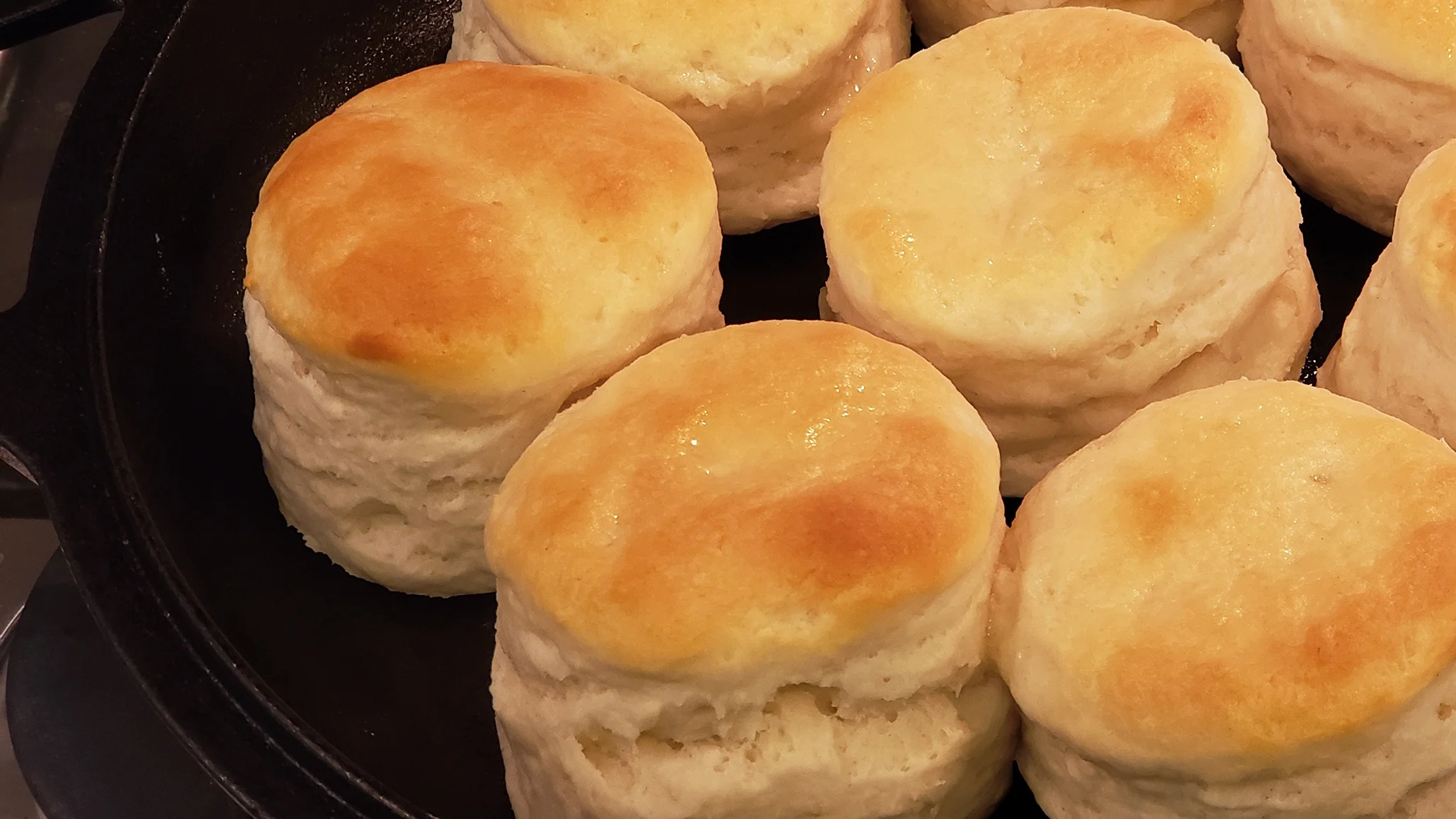
The biscuit recipe that challenged everything I knew
I make good biscuits. Very good biscuits. And a lot of what I know about biscuits can be applied to this authentic southern recipe. But the basic method and ingredients are unlike any biscuit recipe I’d ever made!
A few weeks ago I watched this biscuit how-to video by an absolutely charming southern grandma named Brenda Gantt, and it flipped many things I knew about making biscuits on their heads.
She doesn’t use a mixing bowl
I mean, first of all, she mixes the dough for her biscuits in the bowl she keeps her flour in. I have had endless conversations in the past couple of weeks about how that works, and why she doesn’t have bugs in her flour, or flour that’s gone bad.
But if you watch the video closely, it really does appear that every bit of buttermilk and shortening is picked up by the end, leaving nothing but pristine flour. Plus, you don’t have a bowl to wash!
And even if a little bit of something did get left in the bowl, I bet she uses that flour up pretty quickly. She mentions in the video that she has two different kinds of flour: White Lily self-rising, and regular White Lily. I have, at last count, fifteen different kinds. If I left bits of anything in my flour, by the time I got around to using it again it would be rancid.
She does everything by feel, no measurements
That’s, like, the exact opposite of how I bake. With cooking I get a little more free-wheeling, but with baking I like to be precise!
She doesn’t use butter
I’d never made biscuits without butter before (except for one batch of cream biscuits that I didn’t like very much). I’ve done a lot of experimenting with cookies and pie crusts using butter vs. Crisco, but I always thought that biscuits needed all butter. Boy, was I wrong.
Crisco definitely gives you a different taste than butter (I need to try these with butter-flavor Crisco), but it also gives you a much lighter, fluffier biscuit!
She mashes everything together
There’s no cutting in of fat and flour, and then adding the liquid and tossing gently. Nope, she just mashes the Crisco together with the buttermilk, gradually mixing in the flour. So much easier than using a pastry blender and cold, hard butter!
She puts her biscuits close together, in a cast iron griddle
Brenda bakes her biscuits on a cast iron griddle, not a baking sheet, and she puts them right next to each other. I used to space mine out, because I thought the insides might not cook all the way.
Well, not only do they cook with Brenda’s method, you also get soft, fluffy sides on most of the biscuits.
She bakes at a really high temp
As Brenda says, “They wouldn’ta put 500 degrees on there if they hadn’t wanted you to use it now, right? The quicker it cooks, the tenderer your biscuits are.” And here I thought I’d been cooking mine too high at 450!
But it’s true. The insides cook before the outsides have a chance to get dark and tough.
My attempt at Brenda’s easy biscuit recipe
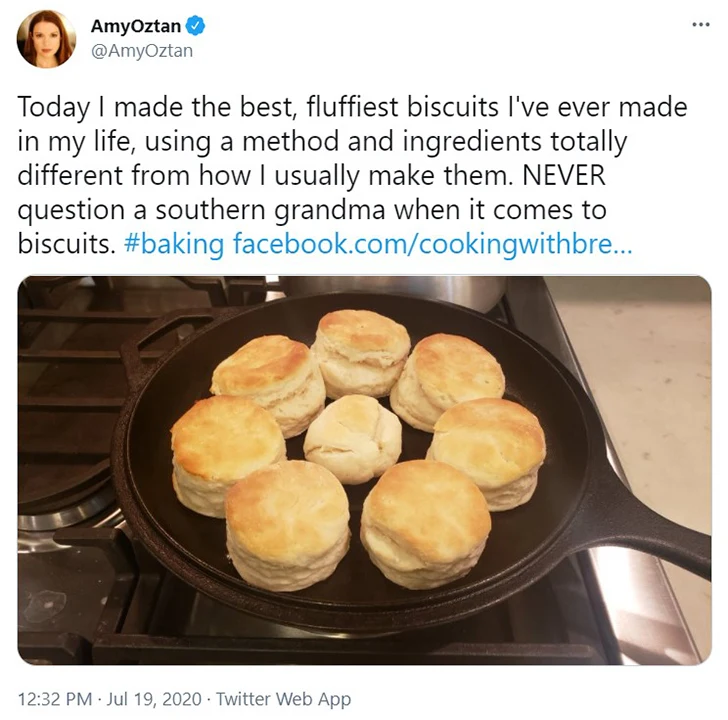
Where to find White Lily flour
Of course I had to try it! But there was one major problem: I didn’t have any White Lily flour.
Now, Brenda doesn’t make a big deal about using White Lily self-rising flour at all. Where she lives it’s probably everywhere. But I’ve never ever seen it in a store in the northeast. And southern bakers go on and on about how it’s just the best flour out there.
A friend suggested that 2/3 all-purpose flour mixed with 1/3 cake flour gives you a pretty good substitute for White Lily, and I will probably try that at some point and do some comparisons. But I needed White Lily Self Rising, so if I substituted I would also have to approximate self-rising flour. I really just wanted to try this with the real thing.
(Incidentally, don’t let people tell you that you can make your own self-rising flour, and that it will be exactly the same. Yes, you can add baking powder and salt to regular flour, and it will rise, but real self-rising flour is made with a different kind of wheat, and the flour ends up being lighter and softer than all-purpose flour. It might not make a difference with some recipes, but with others it will.)
Years ago I’d looked for White Lily on Amazon, and couldn’t even find it there. So, I gave up my search. But now White Lily Flour is so much easier to get!
I had to use a mixing bowl

I couldn’t make myself mix the dough in my big container of White Lily flour. I just couldn’t!! But now that I have a lot more of that precious flour on hand, I might try it at some point. I have to work up the courage.
It’s not just the potential contamination of the flour that scares me, it’s the thought of not measuring anything!!
Everything else went just like she said. I didn’t have a cast iron griddle, but I did have part of a cast iron Dutch oven, which had fairly low sides, so I used that.

After I first posted this, I ordered an inexpensive cast iron griddle, and the lower sides really did make better biscuits. The recipe below is for that 10.5″ pan, so if you use a different-szed pan you may have to adjust the recipe.
I had to figure out the measurements
Remember, Brenda does everything by feel. The reason that works especially well for this recipe is that she’s allowing the dough to pick up just as much flour as it needs, and leaving the rest in the bowl. Since I was too chicken to mix my dough in the bowl, I needed some measurements to start with. So, I used the ones on the back of the White Lily bag.
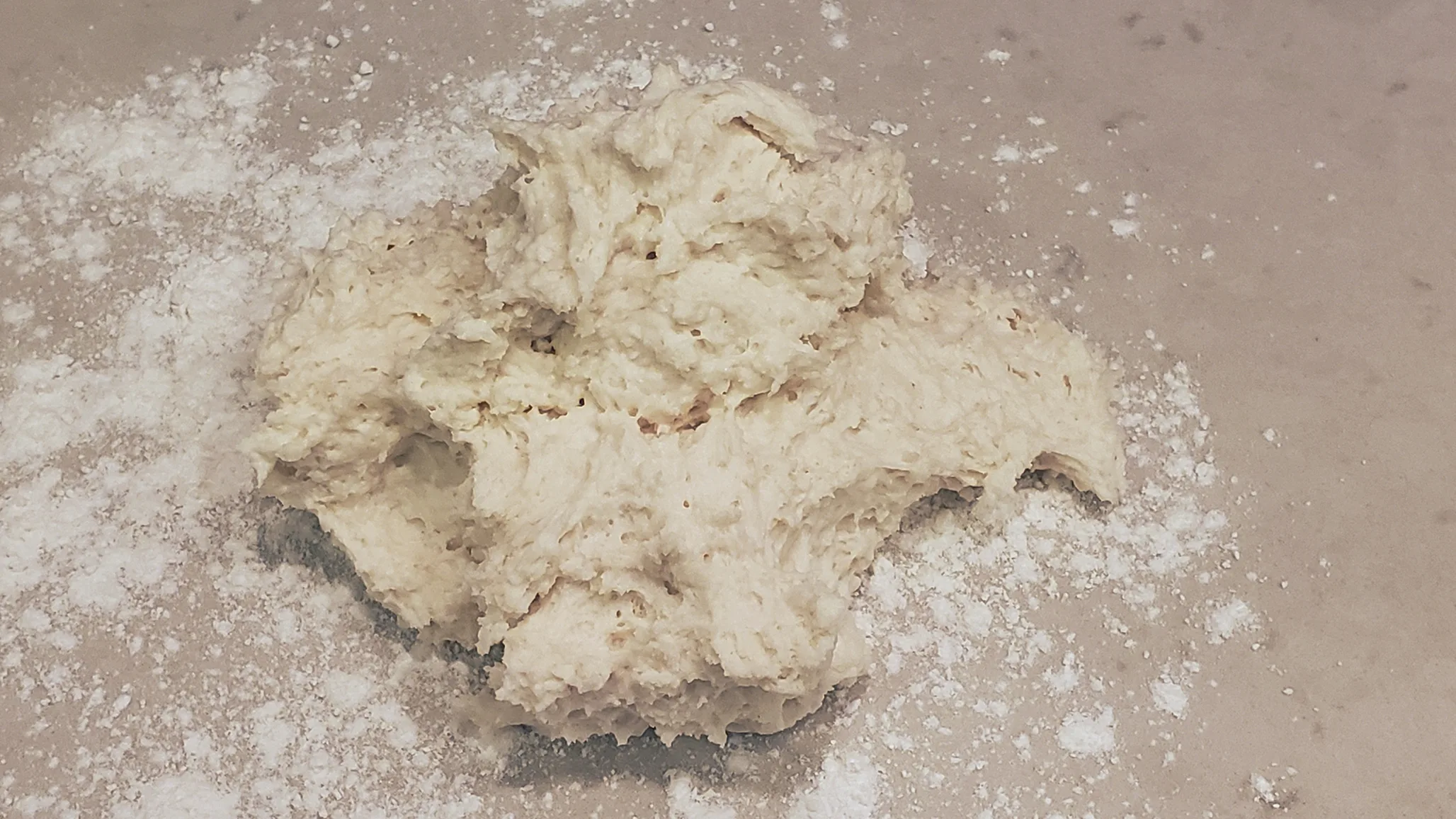
After lots more batches I determined that I needed a bit more flour than the bag said, but not much. I just don’t like working with dough that’s super sticky. It was sticking to my biscuit cutters.
Brenda’s dough is ready to go out of the bowl—she just pats it down and starts cutting. But since I’m not doing her flour bowl method (yet!), I knead it a few times after I take it out of the bowl, to get a little more flour in there.
The best homemade biscuits I’ve ever made

That first batch was amazing!! I ate one hot out of the oven, and then went back for a second. I ate them plain. They didn’t need a thing.
They were light, they were fluffy, and the bottoms were perfect!!
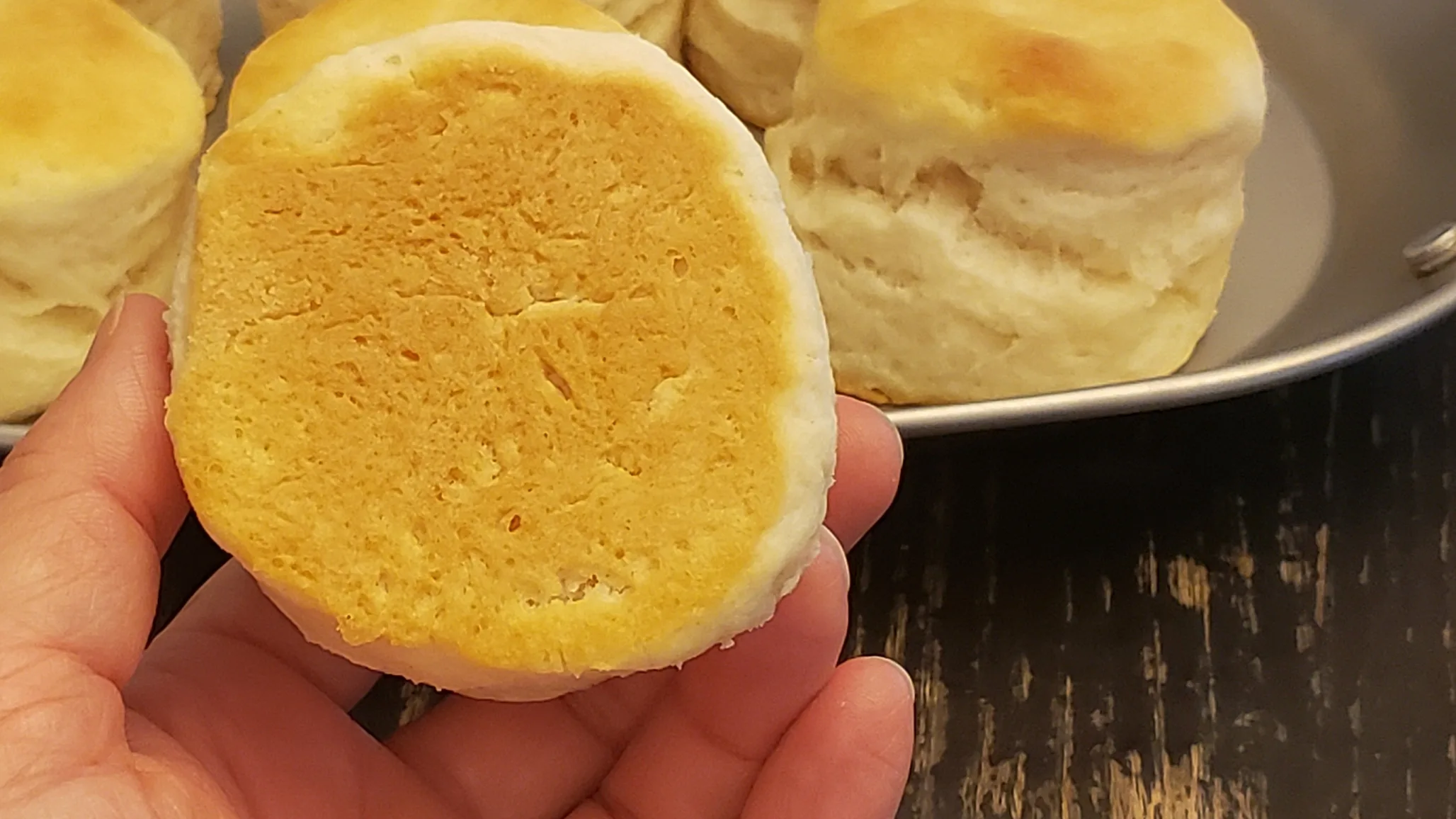
(Have I mentioned that I’m on Weight Watchers? That first batch was six points per biscuit and worth every one!!)
The only little quibble I had was that I thought they needed some salt. I like things salty.
I thought that maybe brushing some salted butter on top would take care of it, but I also really wanted to add a bit to the dough itself. And, I wanted to try it out in one of the higher-sided cast iron pans I had, the eight-inch pans, because I thought that people would be more likely to have those than a griddle.
So, I got to work.
Last Sunday I made five batches of biscuits, and then a couple more on Monday and Tuesday to make sure that all of the changes I’d made added up to something that could be reproduced time after time.

What my biscuit experiments found
A little more salt works great
For my second batch I added half a teaspoon of salt. Self-rising flour already has some salt, but I wasn’t sure how much. If you google recipes for self-rising flour, they’re pretty much split between adding 1/4 teaspoon and 1/2 teaspoon per cup of flour. Since I was starting with two cups of flour, I decided to add 1/2 teaspoon of regular table salt.
I think that was the perfect amount…for me. Like I said, I like food really salty. And when I bit into that batch, I could definitely taste the salt! But I know they would be too salty for normal people, so I dialed it back in subsequent batches. Combined with a brush of melted salted butter, they’re perfect.
You can use any kind of buttermilk
Brenda says that she likes to use whole milk buttermilk, and what she means by that is whole milk cultured buttermilk. I’ve also made it with fat-free cultured buttermilk, milk mixed with lemon juice or vinegar, and plain old milk with buttermilk powder mixed into the dry ingredients. They all taste great.
However, which one you use will affect how much flour you need when you pat the biscuits out. If you use whole milk cultured buttermilk, you probably won’t have to add any more flour at all. Whole cultured buttermilk is super thick, so you’re adding less liquid than if you use a thinner buttermilk.
A high-sided cast iron pan does not work as well

For the third batch, I baked them in my eight-inch cast iron pan. My other two batches had baked perfectly in the lower-sided pan in twelve minutes, but after twelve minutes in the higher pan, the sides of the biscuits looked a little doughy. I baked them for another two minutes, and the sides looked right, but the tops were too brown. They also didn’t rise as high as the first two batches.
I think the high sides of the pan protect the biscuits a bit too much, while allowing the tops to cook too fast.
So, I tried another batch, number four, and I made these biscuits shorter (I’d done the previous ones about an inch high, and I made these a little less than 3/4-inch). The tops didn’t get too dark like the batch before, but they also didn’t rise as much as the first and second (taking into account the shorter starting height).
These were by no means bad biscuits, but they weren’t the light, fluffy biscuits I’d made before.
The bottom of a cast iron pan works a little better

For batch number five, I got the genius idea of flipping the eight-inch pan over. I figured the bottoms would still be protected, but the sides would get the heat they needed. And I think I was pretty much right.
The only problem was, the biscuits leaned outwards a bit. I think the little bit of support the biscuits get on a low-sided pan as they start to rise is enough to help them rise up straight, while not blocking them from the heat too much.
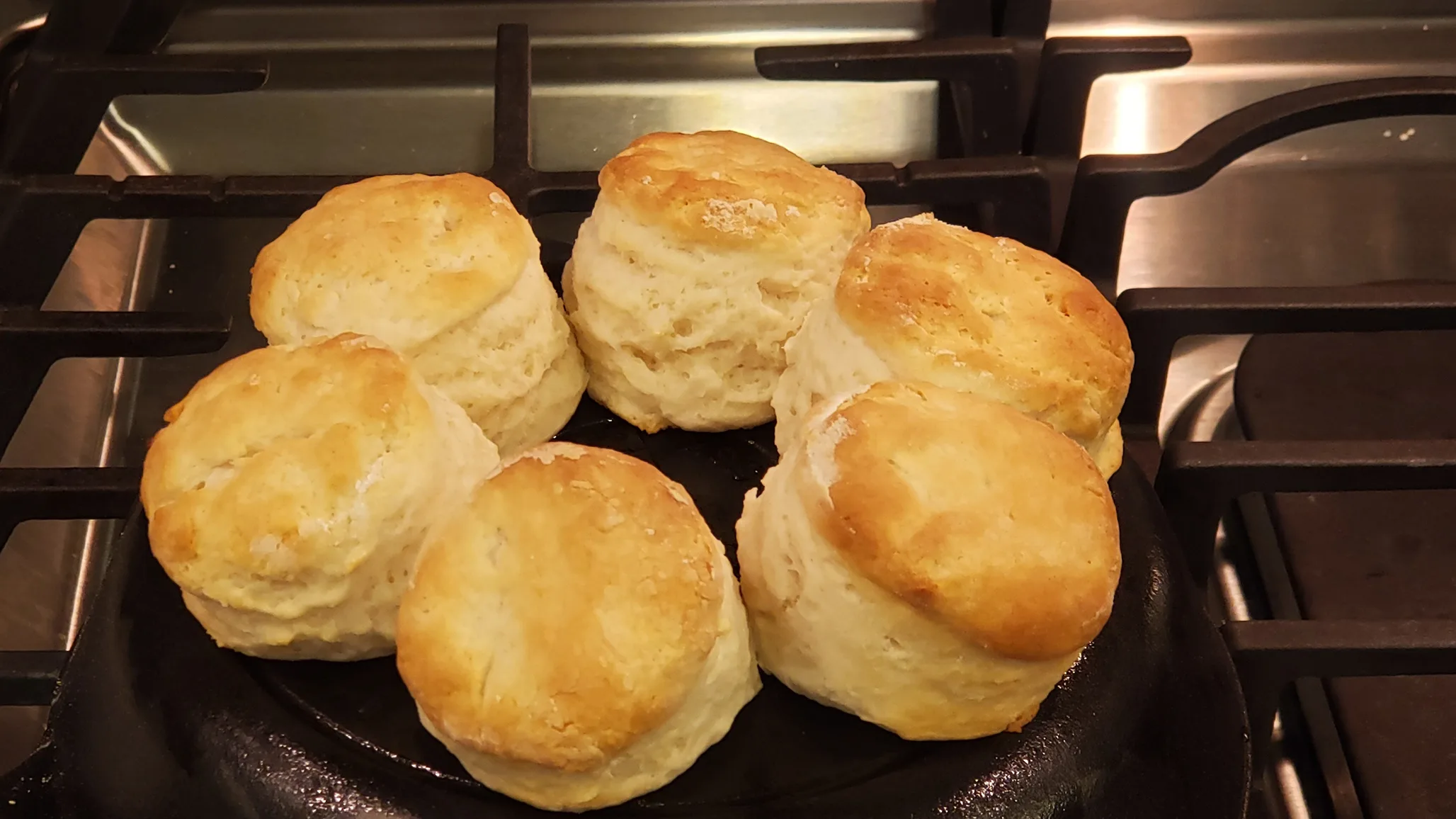
But if you don’t have a low-sided pan, I think the upside-down pan is your best bet. Just be aware that a bit of Crisco might drip off of your pan and into your oven.
I want to try this again with the bottom of a larger pan, just because you can’t fit many biscuits on an eight-inch pan. Perhaps with a larger pan and more rings of biscuits, the inner biscuits wouldn’t lean, and you’d get some straight biscuits? Making the biscuits shorter would also probably help. If I try this I’ll update the post.
Of course, if you just want more butter flavor, and don’t care as much about how they look, you can brush some on both before and after baking.
Don’t forget to make a biscuit for your dog!
I don’t have a dog, but I did what Brenda said anyway and made a big biscuit out of the scraps, because I love using this mini cast iron pan!

I have this set of biscuit cutters, and I usually use the biggest one and the next-biggest one.
More tests are coming

I’m not done testing. (I’m never done testing!) I want to try making these on a baking sheet, and then with non-White Lily flour. I want to try making my own biscuit recipe in a cast iron pan at 500 degrees, and then with White Lily flour, to see what changes.
This recipe works, but I still don’t understand if one part of it is more important than the other parts, or if you need to do all the parts of it in order to be successful. I will try to answer those questions for you!
But for now, just know that following these instructions, with these ingredients, you will make amazing biscuits.
If you want even more biscuits tips, I have a bunch here. And if you want to freeze some of the dough to use later, it’s really easy!
Easy Southern Biscuits Recipe
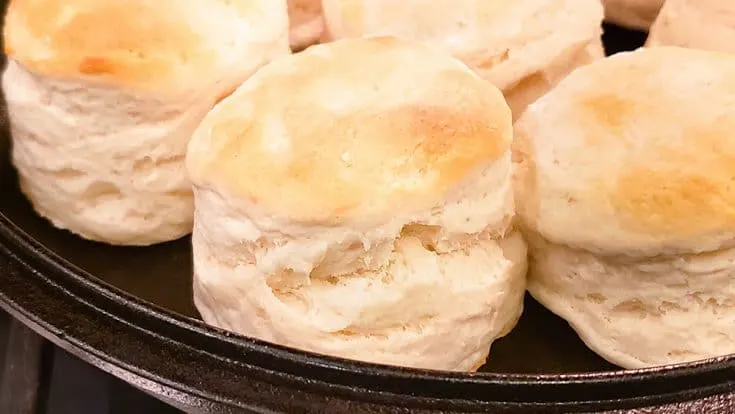
These light, fluffy, buttermilk biscuits come together so quickly, you'll never cut butter into flour again!
Ingredients
- 383 grams (3 cups plus 3 tablespoons) White Lily Self-Rising Flour, plus extra for dusting
- Rounded 1/4 teaspoon salt (use 1/2 teaspoon if you like things really salty)
- 1 cup + 2 tablespoons cold, cultured buttermilk (whole-milk or fat-free), plus a little extra if using whole-milk buttermilk
- 72 grams (6 tablespoons) cold Crisco shortening, plus more for pan
- 21 grams (1-1/2 tablespoons) salted butter, melted
Instructions
- Preheat the oven to 525°F with a rack in the middle position
- Spread some Crisco on the bottom of a 10.5" cast iron griddle
- In a medium bowl, sift the self-rising flour with the salt, then make a well in the middle (if you're using whole-milk buttermilk, leave a couple of tablespoons of flour out, you might not need as much)
- Pour the buttermilk into the well, then add the Crisco shortening
- Squeeze the Crisco and buttermilk together with one hand, trying to get rid of all the lumps of Crisco, gradually bringing more of the flour into the mixture as you go, until all of the flour is incorporated (the dough should be a little sticky; add a little more flour if it's super sticky)
- Wash and dry your hands
- Sprinkle a little flour on your work surface, and rub some on your hands too
- Grab the dough out of the bowl and gently knead it a few times, adding a small amount of flour if it's still very sticky (a little sticky is good)
- Pat gently until about 1-inch thick and cut out with a biscuit cutter, flouring the cutter after each cut and rubbing off any stuck dough
- Place each piece of dough in the prepared cast iron griddle, starting at the outside edge and then filling in the middle, placing the biscuits so that they're touching
- Once you've cut all you can out of the dough, gently knead what's left a few more times, and pat it out again, cutting the rest; try to only do this twice
- If you have dough left over, you can save it for something else, or make one big biscuit and bake it on a separate pan
- Put the pan in the oven on the center rack and immediately reduce the heat to 500°F
- Bake for 12 minutes, or until tops are golden and the sides look dry
- Brush the tops with melted butter and serve hot
Notes
- If you don't have a cast iron griddle or some other cast iron pan with low sides, turn a cast iron pan over and use the bottom as your baking surface. Just make sure you put a sheet pan or cookie sheet on the rack below, because some Crisco will probably drip.
- A 2-3/4-inch biscuit cutter will get you a good-size biscuit, but you can really use any size.
- You can make shorter biscuits, too! I've patted the dough anywhere from 1/2-inch to 1-inch and it all worked well. I like them thinner for breakfast sandwiches, but taller for eating plain.
- A note about timing: if your oven is slow to pre-heat, these biscuits will take longer than 20 minutes, so start preheating before you mix up the dough. You don't want the dough to get warm while waiting for the oven!
- If you do find yourself in that situation, put the pan of biscuit dough in the fridge until the oven has preheated.
Recommended Products
As an Amazon Associate and member of other affiliate programs, I earn from qualifying purchases (but you won't pay anything extra!)
Nutrition Information
Yield
8Serving Size
1Amount Per Serving Calories 92Total Fat 3gSaturated Fat 2gTrans Fat 0gUnsaturated Fat 1gCholesterol 6mgSodium 314mgCarbohydrates 13gFiber 0gSugar 1gProtein 2g
Nutritional information is an estimate only.

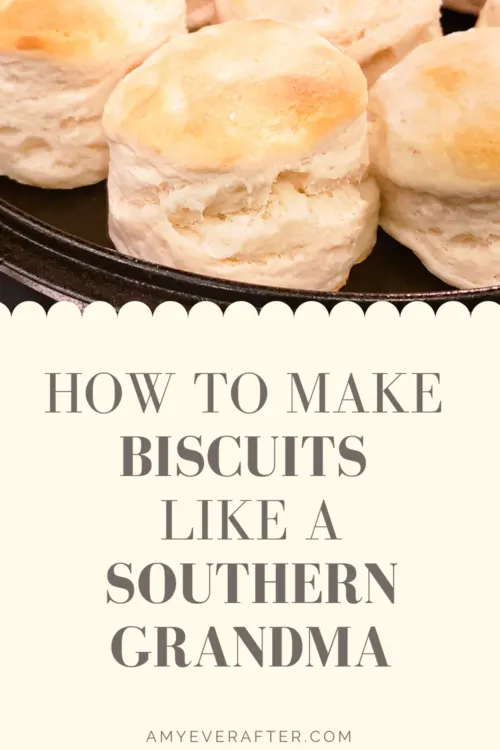





Scott
Saturday 2nd of July 2022
Thank you so much for this article! My aunt made biscuits in her flour container using White Lilly flour and they were amazing. I’ve tried to make biscuits like hers without a lot of success. The main difference in my aunt’s was that she patted them out in her left hand and used the top of the fingers of her right pat them out and then arranged them in a cast iron skillet with sides touching. I can’t wait to try this!
Sue Ella Robinson
Wednesday 29th of December 2021
I was so glad to find your recipe. I have wanted to make Brendas’s but no room for a bowl to keep the flour in. I made yours today and they were wonderful. I now need to order the Lodge griddle. How did yours do when you got your griddle? Didn’t see an update.
Amy Oztan
Thursday 30th of December 2021
Oh man, I never posted an update!! Thank you for the reminder. But the pan is GREAT. It's perfect for these biscuits. It's bigger than what I was using, so I've found that making 1.5 times the recipe is perfect.
Mary
Sunday 3rd of October 2021
I use White Lily Self Rising flour to make my biscuits like Brenda Gantt. They turn out great. For those of you that can't find White Lily, you can order it on line at Kroger.com. That is what I do because I can't get it in the stores in Arizona.
Angela
Saturday 2nd of October 2021
I have no time to try this yet...but I am going to! I actually just watched her video today and loved it. I did a search on bisquits in a bowl with flour, (something like that) and yours popped up. Thanks!
Valerie
Thursday 29th of July 2021
I just tried this recipe, after buying the White Lily flour and a cast iron griddle on amazon. I should tell you I live at about 5280 altitude. Yes, that's the mile-high city (Denver). My dough was too dry. I followed the directions scrupulously. The dough wasn't close to sticky; it would barely hold together. The biscuits looked and tasted pretty good, but were a little crumbly. Of course, this sounds like I need more Crisco. I used butter-flavored Crisco. Any thoughts on making the finished product more moist?
Patti
Saturday 4th of June 2022
@Valerie, Add more buttermilk
Jo
Saturday 31st of July 2021
I believe u did not add enough buttermilk and/or Crisco. I baked mine at 8500 Altitude and they baked beautifully. I didn’t have a cast iron skillets, I used a pizza pan lined with aluminum foil. Worked very well, light brown on outside and flakey inside.
Amy Oztan
Friday 30th of July 2021
I'm so sorry to hear that they didn't turn out well! I have to admit that I have very little experience with high-altitude baking, so if any of my readers are experienced in this I hope they'll chime in. From what I do know, the high altitude causes your flour to be much drier, so I'm tempted to make my first suggestion to decrease the flour by about a tablespoon per cup, which is the normal standard change for high-altitude recipes. BUT, I think in this case, since your dough was SO different from mine, you might be the perfect candidate for making the recipe like Brenda does in her video, because the Crisco and buttermilk pick up the amount of flour they need to, without measuring. If you don't want to try that, I would reduce the flour by more, maybe even by 2 or 3 tablespoons per cup, because for this recipe it would be easier to add more flour than more Crisco. Try to keep track of how much you add back in, so that you don't have to guess next time. And I hate to mention it, but flour is THE most miss-measured ingredient out there, so if you're not weighing the flour, please just make sure you're sifting it and then spooning it into the measuring cup (not using the cup to scoop the flour), since otherwise you'll end up with too much flour.